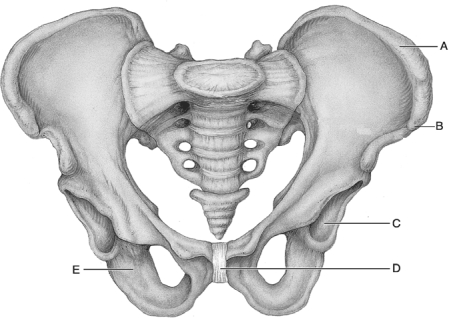A) medially
B) laterally
C) anteriorly
D) posteriorly
F) C) and D)
Correct Answer

verified
Correct Answer
verified
Multiple Choice
The intercondylar eminence is found on which of the bones listed below?
A) radius
B) tibia
C) ulna
D) humerus
F) A) and D)
Correct Answer

verified
Correct Answer
verified
Multiple Choice
The bony landmark at the lateral angle of the scapula is the
A) spine.
B) acromion.
C) glenoid cavity.
D) suprascapular notch.
F) A) and C)
Correct Answer

verified
Correct Answer
verified
True/False
The ischium forms the posteroinferior region of the pelvic girdle.
B) False
Correct Answer

verified
Correct Answer
verified
True/False
The metacarpus is the palm of the hand.
B) False
Correct Answer

verified
Correct Answer
verified
True/False
The tibia articulates distally with the trochlea of the talus.
B) False
Correct Answer

verified
Correct Answer
verified
Multiple Choice
The fibula
A) crosses the tibia when the leg is rotated.
B) forms the lateral border of the knee joint.
C) stabilizes the ankle joint.
D) articulates with the femur.
F) A) and C)
Correct Answer

verified
Correct Answer
verified
Multiple Choice
Which border of the scapula is proximal to the vertebral column?
A) inferior
B) lateral
C) medial
D) superior
F) B) and C)
Correct Answer

verified
Correct Answer
verified
Short Answer
When you sit cross-legged for a while on a hard surface, your ʺrear endʺ hurts because you have been distributing weight directly over your bony tuberosities.
Correct Answer

verified
Correct Answer
verified
Short Answer
The pelvic girdle consists of the paired .
Correct Answer

verified
Correct Answer
verified
True/False
As one ages, the upper-lower (UL) body ratio changes from about 1.7:1 at birth to 1:1 at puberty.
B) False
Correct Answer

verified
Correct Answer
verified
Essay
Describe some of the anatomical characteristics of the female pelvis that are adaptations for childbearing.
Correct Answer

verified
The female pelvis is typically wider, sh...View Answer
Show Answer
Correct Answer
verified
View Answer
Short Answer
The is the tarsal bone lateral to the navicular.
Correct Answer

verified
Correct Answer
verified
Multiple Choice
Which of the following statements concerning the fibula is false?
A) It is the thinnest of the two leg bones.
B) It forms the lateral malleolus.
C) It helps stabilize the knee.
D) It helps stabilize the ankle.
F) A) and C)
Correct Answer

verified
Correct Answer
verified
Multiple Choice
The ischium joins the pubis in the acetabulum and at the
A) pubic symphysis.
B) sacroiliac joint.
C) inferior pubic ramus.
D) superior pubic ramus.
F) All of the above
Correct Answer

verified
Correct Answer
verified
Multiple Choice
Which tarsal bone lies directly anterior to the talus?
A) calcaneus
B) lateral cuneiform
C) navicular
D) cuboid
F) A) and D)
Correct Answer

verified
Correct Answer
verified
Multiple Choice
The acromion of the scapula
A) lies anterior to the coracoid process.
B) attaches the biceps muscle of the arm.
C) is an extension of the scapular spine.
D) articulates with the humerus.
F) C) and D)
Correct Answer

verified
Correct Answer
verified
Multiple Choice
 Figure 8.1
Use the diagram above to answer the following questions.
-Which letter indicates a deep hemispherical socket where all three pelvic bones intersect?
Figure 8.1
Use the diagram above to answer the following questions.
-Which letter indicates a deep hemispherical socket where all three pelvic bones intersect?
A) A
B) B
C) C
D) D
E) E
G) C) and D)
Correct Answer

verified
Correct Answer
verified
Multiple Choice
All of these statements regarding the acetabulum are true except
A) The acetabulum is cup-shaped.
B) The acetabulum participates in the hip joint.
C) The acetabulum is where the three pelvic bones intersect.
D) The acetabulum articulates with the sacrum.
F) B) and C)
Correct Answer

verified
Correct Answer
verified
Multiple Choice
The ulnar notch is found on which of the bones listed below?
A) radius
B) tibia
C) ulna
D) humerus
F) A) and C)
Correct Answer

verified
Correct Answer
verified
Showing 61 - 80 of 110
Related Exams